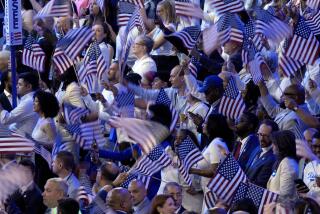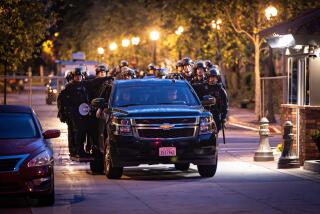Return Engagement : Peace Symbol of the ‘60s Gains New Luster as the Gulf War Rages
It was a sign of the times. During the decade that hippies turned into yuppies, Ken Lauher’s customers occasionally brought in their gold and silver peace-symbol trinkets to have them melted down.
“I made a lot of peace signs in the ‘60s and ‘70s, but in the ‘80s they were as dead as a doornail,” said the Laguna Beach jewelry designer.
In recent weeks, however, the seemingly passe anti-war symbol has risen from the ashes of the Reagan era. “I’m starting to get requests for peace signs again,” Lauher said. “They’re really coming back in style. I’m seeing them everywhere--on the streets, on television.”
Throughout its 33 years of existence, the peace sign has been both flaunted and mistrusted. It was crafted by British and American “Ban the Bomb” advocates in 1958 but did not become a familiar sight until Vietnam War objectors adopted it.
Peace signs, along with bell bottoms and fishnet stockings, were popular during the ‘60s. Mocked as “the footprint of a chicken” by anti-anti-war protesters, the emblem dangled from macrame bracelets and glowed from fluorescent posters.
Twenty years later, fueled by another war, a new generation is embracing the dusty badge of idealism. And many members of the generation that first popularized the peace sign are paying an old friend its due respect.
Wacko, an offbeat gift shop on Melrose Avenue, has stepped up its shipments from memorabilia suppliers who specialize in ‘60s merchandise.
“They’re hauling out of their warehouses peace-sign stickers and buttons--tons of original stuff from 20 years ago,” said the store’s manager, who calls himself Gorilla. “The peace sign has gone from being a minor novelty to a major novelty.
“Basically, we have an anti-war crowd on Melrose,” Gorilla said. “A lot of them are draft age. This is their first war, and if a peace-sign button can ward it off, they’ll buy it. It’s like voodoo.”
Soap Plant, Wacko’s sister store and next-door neighbor, also has ordered extra peace-sign products--including a Bart Simpson T-shirt on which the cartoon character greets onlookers with, “Peace, man.”
Manager Michel Chenelle has mixed feelings about increasing Soap Plant’s stockpile of the items in demand because of Desert Storm. “It’s like I don’t want to order stuff because I don’t want the war to go on,” she said. “It kind of seems like giving up.”
Nicole Frantz of Na Na boutique in Santa Monica expressed a similar uneasiness: “We’ll probably order more (peace-sign jewelry), but I think it’s too bad that people have to display that desire again.”
Peace-sign sales at the trendy Los Angeles shop Heaven have tripled, according to manager Cary Groman.
“Something emotional happens when people see a peace sign nowadays,” said Elinore Eklof, manager of the Spiral Staircase in Topanga Canyon. “It moves them.”
“Before the war broke out, it was mostly teen-agers who were buying peace signs,” said Sawez Afzali, owner of Designer Cargo in Westchester. “But since the war started, I’ve sold a lot to people in their 30s and 40s. My customers say things like, ‘We need peace these days’--even those who support (the military action against Iraq).”
One customer, Santa Monica resident Patricia Colton, said she bought her silver peace-sign earrings “to make a personal statement.”
That statement “is not necessarily in total opposition to the war,” the 31-year-old administrative assistant added. “Wearing the earrings is just my way of saying that I hope the war ends soon.”
In times of uncertainty, said pop culture expert Todd Gitlin, “people always reach back to some available past” for a sense of direction.
“Given the fact that a quarter of the country is against the war, it’s not surprising that people are looking for some sort of symbol of their commitment,” said Gitlin, a sociologist at UC Berkeley and author of the 1987 book, “The Sixties: Years of Hope, Days of Rage.”
Elliott Mitchell sells peace signs but has never worn one--even though he describes himself as “a child of the ‘60s.” Mitchell fought in Vietnam and, two decades later, has a 20-year-old son stationed in Saudi Arabia.
“I marched in civil rights demonstrations, but I was never involved in anti-war protests,” said Mitchell, co-owner of Blue Moon Gifts in Huntington Beach.
Still, he appreciates the peace sign, although he views the Vietnam conflict and Desert Storm as “just wars.” In fact, he is a bit protective of his generation’s symbol: “When I see young people coming in wearing peace signs, I wonder if they really know what it means. I wonder if it is a hot fashion item more than a sincere devotion to an ideology.”
Peace advocates play a crucial role in wartime, Mitchell said: “It’s good that there is a movement against the war--it keeps our politicians on their toes. If all we had was rampant war, war, war sentiment, they might not be so conscientious about keeping casualties in check.”
And whether a meaningful statement or a superficial fad, the peace sign is--at worst--harmless, said Mitchell.
“I don’t think that it’s deprecating to our troops or even to our foreign policy. If I did feel that way, I would not have it in my store merely to make a buck.”
More to Read
Sign up for Essential California
The most important California stories and recommendations in your inbox every morning.
You may occasionally receive promotional content from the Los Angeles Times.










